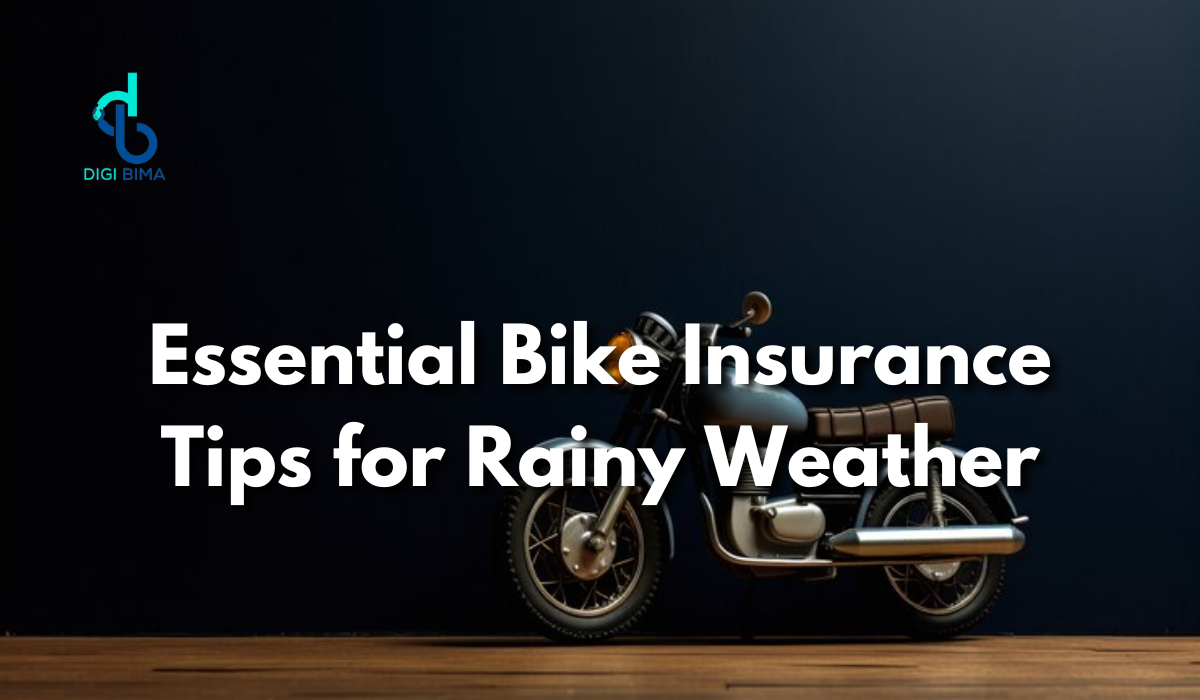During the monsoon season, bikers face both relief from the scorching heat and challenges. Riding in the rain demands extra caution to ensure safety and protect your bike from potential damage. It’s essential to have comprehensive Bike Insurance coverage to safeguard against unforeseen circumstances during this period.
At Digibima, we understand the importance of bike insurance, especially during the rainy season. This guide provides essential tips to help you navigate the rainy weather safely and ensure your bike insurance coverage is up to date.
Importance of Bike Insurance in Rainy Weather
Riding a bike in rainy weather exposes it to various risks such as skidding, aquaplaning, and damage from waterlogging. Bike insurance plays a crucial role in providing financial protection against these risks. Here’s why having bike insurance during the rainy season is essential:
-
Accident Coverage: Rain-slick roads increase the risk of accidents. Comprehensive bike insurance provides coverage for damages to your bike and injuries to yourself and third parties involved in an accident.
-
Damage Due to Waterlogging: Waterlogging can damage your bike’s engine and electrical system. Comprehensive insurance covers these damages, providing financial assistance for repairs or replacement.
-
Theft and Vandalism: Incidences of theft and vandalism may increase during the rainy season. Having comprehensive insurance ensures you’re covered if your bike is stolen or damaged due to vandalism.
-
Third-party Liability: In case you cause damage to a third party’s property or injure someone while riding in the rain, third-party liability insurance covers the financial liabilities.
Essential Bike Insurance Tips for Rainy Weather
-
Check Your Insurance Policy: Ensure your bike insurance policy is active and covers monsoon-related damages. If necessary, consider upgrading to a comprehensive plan for better coverage.
-
Regular Maintenance: Keep your bike well-maintained, especially during the rainy season. Check brakes, tyres, lights, and electrical systems regularly to avoid breakdowns.
-
Use Quality Rain Gear: Invest in good quality rain gear to stay dry and comfortable while riding. This not only improves visibility but also reduces the chances of accidents.
-
Avoid Puddles and Waterlogged Areas: Try to avoid riding through puddles and waterlogged areas as they can damage your bike’s engine and increase the risk of skidding.
-
Park Safely: Park your bike in a safe and covered area to protect it from rain, theft, and vandalism.
-
Claim Process Awareness: Familiarize yourself with the claim process of your insurance company.
-
Rider Add-ons: Consider adding riders like engine protector or roadside assistance to your policy for additional protection during the rainy season.
Riding Safely in the Rain
-
Reduce Speed: Slow down to reduce the risk of skidding on wet roads. Make sure to leave some distance between yours & the other’s vehicles.
-
Use Both Brakes: Apply both the front and rear brakes gently to avoid locking up the wheels. Practice braking in a safe area to get a feel for how your bike handles in wet conditions.
-
Avoid Sudden Movements: Make smooth and gradual turns, accelerations, and decelerations to maintain traction and stability.
-
Stay Visible: Use headlights and reflective gear to improve visibility, especially in heavy rain or low light conditions.
-
Watch for Hazards: Be aware of slippery surfaces, potholes, and debris hidden under puddles. Avoid sudden maneuvers to navigate these obstacles safely.
-
Plan Your Route: Choose routes that are less prone to waterlogging and have good drainage systems. Avoid areas prone to flooding.
Choosing Comprehensive Coverage
-
Cover for Flood Damage: Comprehensive insurance covers damages caused by natural disasters like floods, ensuring you’re protected even in the worst rainy season scenarios.
-
Theft and Vandalism: Comprehensive insurance provides coverage for theft or vandalism, which may increase during the rainy season due to reduced visibility and security measures.
-
Peace of Mind: Knowing that you have comprehensive coverage gives you peace of mind, allowing you to enjoy your ride without worrying about potential financial burdens.
Common Mistakes to Avoid
-
Ignoring Maintenance: Neglecting regular maintenance can lead to avoidable breakdowns and accidents, especially in rainy weather.
-
Riding Without Insurance: Riding without insurance is not only illegal but also leaves you financially vulnerable in case of an accident or damage.
-
Not Updating Policy: Failing to update your insurance policy to include monsoon-related coverage can lead to unexpected expenses in case of damage or theft.
Real-Life Example
Mr. Kapoor, a bike enthusiast from Delhi, experienced the importance of bike insurance during the rainy season. While riding to work during heavy rain, his bike skidded on a slippery road, causing minor damages. Thankfully, Mr. Kapoor had comprehensive bike insurance, which covered the repair costs, ensuring he didn’t have to bear the financial burden.
Conclusion
Riding a bike in rainy weather requires extra caution and preparation. By following these essential tips and ensuring your bike insurance is up to date, you can enjoy a safe and worry-free riding experience during the monsoon. At Digibima, we’re here to help you choose the right bike insurance policy that provides comprehensive coverage for all your needs. Stay safe, stay insured!
FAQs about Bike Insurance in Rainy Weather
Q1: Will my insurance cover damages if my bike skids in the rain?
A1: Yes, if you have comprehensive insurance, damages due to skidding in the rain are typically covered.
Q2: Does bike insurance cover damages from waterlogging?
A2: Yes, comprehensive insurance covers damages to your bike’s engine and electrical system caused by waterlogging.
Q3: Can I make a claim if my bike is stolen during the rainy season?
A3: Yes, comprehensive insurance covers theft of your bike, including incidents that occur during the rainy season.
Q4: Is roadside assistance included in bike insurance?
A4: Roadside assistance is not typically included in standard bike insurance but can be added as a rider for an additional cost.


